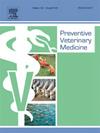Risk factors for smothering in three commercial free-range layer poultry farms, Australia 2019–2022
IF 2.2
2区 农林科学
Q1 VETERINARY SCIENCES
引用次数: 0
Abstract
In intensively managed poultry production systems the term ‘smothering’ refers to deaths from suffocation that occur as a consequence of piling behaviour where birds crowd together into densely packed groups. Smothering is a non-negligible source of loss in free-range layer hens, having both negative welfare and economic effects. Smothering events are rarely observed and are usually detected by the discovery of groups of dead hens. The aim of this study was to identify risk factors for smothering deaths in three commercial free-range layer poultry farms in Australia. This was a prospective cohort study of poultry flocks managed by three commercial free-range layer farms in eastern Australia. Flocks were enrolled into the study from 1 January 2019–29 March 2021 and were followed until the end of lay or until the end of the study on 31 March 2022, whichever occurred first. Throughout the follow-up period of the study, daily production and weather data, details of flock management and details of the place and time of smothering events were recorded. Time to event (survival) analyses were used to quantify the association between hypothesised risk factors and the number of days in lay at the time of smothering. Shed and bird level characteristics associated with time to event were quantified using a stratified Cox proportional hazards model which included a frailty term to account for birds clustered within sheds within farm. Across the three farms, for every 100 birds placed into a shed, there were 12 deaths over the duration of the production period. Of the 12 deaths per 100 birds, 2 were due to smothering. Our Cox proportional hazards regression analyses showed that the daily hazard of smothering was increased for birds housed in aviary sheds compared with flat-deck sheds (HR 4.0, 95 % CI 1.7–9.7). The daily hazard of smothering mortality was increased on warm, humid and rainy days, and in birds with low fear of humans and high fear of novel objects. Rainy days on which outdoor daily average humidity was greater than or equal to 70 % were associated with a 3.7 (95 % CI 3.5–3.9) fold increase in the daily hazard of indoor smothering deaths, compared with days when outdoor daily average humidity was less than 70 % and no rain. This study provides useful insight into the determinants of smothering in Australian free-range layer hens, in particular risk factors that do not change over time (e.g., shed type) and those that change daily (e.g., weather conditions). This information allows flock management strategies to be adapted accordingly.
澳大利亚2019-2022年三个商业散养蛋鸡养殖场的窒息风险因素
在集约化管理的家禽生产系统中,“窒息”一词是指由于禽类密集地聚集在一起而造成的堆积行为导致的窒息死亡。窒息是自由放养蛋鸡的一个不可忽视的损失来源,既有负面的福利影响,也有负面的经济影响。窒息事件很少被观察到,通常是通过发现成群的死母鸡来发现的。本研究的目的是确定澳大利亚三个商业散养蛋鸡养殖场窒息性死亡的危险因素。这是一项前瞻性队列研究,研究对象是澳大利亚东部三个商业散养蛋鸡养殖场管理的家禽群。鸡群于2019年1月1日至2021年3月29日( 3月29日)被纳入研究,并被跟踪至产蛋结束或2022年3月31日研究结束,以先发生者为准。在整个研究的随访期间,记录了每天的产量和天气数据、羊群管理的细节以及窒息事件的地点和时间的细节。时间到事件(生存)分析用于量化假设的风险因素与窒息时的卧床天数之间的关联。使用分层Cox比例风险模型对与事件发生时间相关的棚舍和鸟类水平特征进行了量化,该模型包括一个脆弱性术语,用于解释农场棚舍内聚集的鸟类。在三个农场,在生产期间,每100只禽鸟被放入棚里,就有12只死亡。每100只鸟中有12只死亡,其中2只死于窒息。我们的Cox比例风险回归分析显示,与平甲板鸡舍相比,鸟舍内的鸟类每日窒息风险增加(HR 4.0, 95 % CI 1.7-9.7)。在温暖、潮湿和雨天,以及对人类不太恐惧、对新事物高度恐惧的鸟类,窒息死亡的日常风险增加了。室外日平均湿度大于或等于70 %的雨天与室外日平均湿度小于70 %且无雨的雨天相比,室内窒息死亡的日危险增加3.7倍(95 % CI 3.5-3.9)。这项研究为澳大利亚自由放养蛋鸡窒息的决定因素提供了有用的见解,特别是那些不随时间变化的风险因素(例如,鸡舍类型)和那些每天变化的风险因素(例如,天气条件)。这一信息允许对畜群管理策略进行相应的调整。
本文章由计算机程序翻译,如有差异,请以英文原文为准。
求助全文
约1分钟内获得全文
求助全文
来源期刊

Preventive veterinary medicine
农林科学-兽医学
CiteScore
5.60
自引率
7.70%
发文量
184
审稿时长
3 months
期刊介绍:
Preventive Veterinary Medicine is one of the leading international resources for scientific reports on animal health programs and preventive veterinary medicine. The journal follows the guidelines for standardizing and strengthening the reporting of biomedical research which are available from the CONSORT, MOOSE, PRISMA, REFLECT, STARD, and STROBE statements. The journal focuses on:
Epidemiology of health events relevant to domestic and wild animals;
Economic impacts of epidemic and endemic animal and zoonotic diseases;
Latest methods and approaches in veterinary epidemiology;
Disease and infection control or eradication measures;
The "One Health" concept and the relationships between veterinary medicine, human health, animal-production systems, and the environment;
Development of new techniques in surveillance systems and diagnosis;
Evaluation and control of diseases in animal populations.
 求助内容:
求助内容: 应助结果提醒方式:
应助结果提醒方式:


